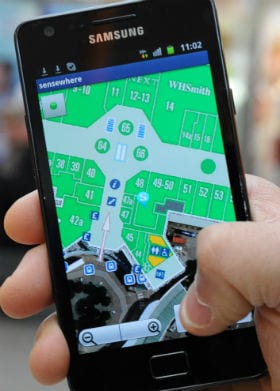 By know you certainly know about — and almost definitely use — GPS. But the next stage of satellite positioning technology is already here, and for people who work out in the field, it may soon become ubiquitous.
By know you certainly know about — and almost definitely use — GPS. But the next stage of satellite positioning technology is already here, and for people who work out in the field, it may soon become ubiquitous.
Whereas GPS technology uses satellites in orbit around the earth to relay your location to a smartphone or that TomTom box in your car, IPS (Indoor Positioning System) uses a chip inside your mobile device to calculate your location based on transmitters located on the ground, like Wi-Fi networks, Near Field Communications devices, and Bluetooth. Why’s this important? Well, if you’ve ever used a GPS in your car, you know how unreliable (or at least imprecise) they can be. And once you’re inside a building, GPS is often a lost cause. But by using transmitters already on the ground — and in places like a mall or a large city, there are literally thousand of Wi-Fi networks available — IPS technology can pinpoint your location to within a foot. The more transmitters, the more precise the location determination.
For field techs entering massive apartment or office buildings, IPS could prove extremely valuable. A tech could sync up his device to track the customer’s device and with little trouble find exactly where they are. If an HVAC service tech is called in for a minor fix in a huge ventilation system, using blueprints and IPS he can avoid getting lost in a maze of steel.
IPS is gaining traction in the market, as well. This Fast Company story profiles IPS provider Wifarer, and another company, YFind, just raised more than $1 million in funding this week. We’ve covered indoor mapping service, like Micello, before, and with the emergence of IPS, there’s a clear movement within mapping that’s moving from the outside in.
Related: Could Indoor Mapping Hold Promise for Field Service?
Click here to download a free whitepaper, “Five Steps to Make Field Service Profitable.”

Share this: